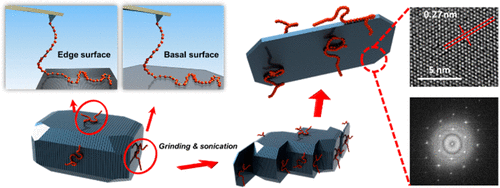当前位置:
X-MOL 学术
›
J. Phys. Chem. C
›
论文详情
Our official English website, www.x-mol.net, welcomes your
feedback! (Note: you will need to create a separate account there.)
Single-Molecule MoS2–Polymer Interaction and Efficient Aqueous Exfoliation of MoS2 into Single Layer
The Journal of Physical Chemistry C ( IF 3.3 ) Pub Date : 2018-03-27 00:00:00 , DOI: 10.1021/acs.jpcc.7b12194 Yuechao Tang 1 , Xurui Zhang 1 , Phillip Choi 1 , Rogerio Manica 1 , Qingxia Liu 1 , Zhenghe Xu 1
The Journal of Physical Chemistry C ( IF 3.3 ) Pub Date : 2018-03-27 00:00:00 , DOI: 10.1021/acs.jpcc.7b12194 Yuechao Tang 1 , Xurui Zhang 1 , Phillip Choi 1 , Rogerio Manica 1 , Qingxia Liu 1 , Zhenghe Xu 1
Affiliation

|
Single molecule force spectroscopy (SMFS) was utilized to study single-molecule interactions between synthesized polymers and MoS2 surfaces that provide the guidance to determine candidate polymers for efficient aqueous exfoliation of bulk MoS2 into single-layer nanosheets. The technique allowed the direct quantification of the adhesion force of single polymer molecules with both basal and edge surfaces of MoS2. Compared with two studied neutral polymers, highly water-soluble cationic poly(vinylbenzyl trimethyl ammonium chloride) (PVBTA) was shown to be more promising for MoS2 exfoliation as a result of strong single-molecule interactions with both basal and edge surfaces of MoS2. In 1 mM NaCl solution of pH around 5.5, the measured single-molecule adhesion forces on basal and edge surfaces were around 59 and 51 pN, respectively. Such strong adhesion force led to high performance of PVBTA in exfoliating MoS2 bulk material into single-layer sheets. Compared with reported approaches in the literatures, an order of magnitude higher concentration of single-layer MoS2 sheets in water was prepared using an order of magnitude less treatment time in this study. This research demonstrated that SMFS is a powerful tool to select appropriate surface-active polymers for effective exfoliation of MoS2, which could be applied to a variety of practical applications, such as water adhesion and dispersing.
中文翻译:

单分子的MoS 2 -聚合物的相互作用和MOS管高效水性剥离2成单层
利用单分子力谱(SMFS)研究合成聚合物与MoS 2表面之间的单分子相互作用,为确定将有效MoS 2水性剥落成单层纳米片的候选聚合物提供指导。该技术允许直接定量单个聚合物分子与MoS 2的基面和边缘表面的粘附力。与研究的两种中性聚合物相比,由于与MoS 2的基础表面和边缘表面都有强的单分子相互作用,高水溶性阳离子聚(乙烯基苄基三甲基氯化铵)(PVBTA)被证明对MoS 2剥离更有希望。。在pH值约为5.5的1 mM NaCl溶液中,在基底和边缘表面上测得的单分子粘附力分别约为59 pN和51 pN。如此强的附着力导致PVBTA在将MoS 2块状材料剥落成单层薄板时具有很高的性能。与文献中报道的方法相比,本研究中使用更少的处理时间来制备水中单层MoS 2薄片的浓度要高一个数量级。这项研究表明,SMFS是选择合适的表面活性聚合物以有效剥离MoS 2的有力工具,可将其应用于各种实际应用中,例如水的附着力和分散性。
更新日期:2018-03-27
中文翻译:

单分子的MoS 2 -聚合物的相互作用和MOS管高效水性剥离2成单层
利用单分子力谱(SMFS)研究合成聚合物与MoS 2表面之间的单分子相互作用,为确定将有效MoS 2水性剥落成单层纳米片的候选聚合物提供指导。该技术允许直接定量单个聚合物分子与MoS 2的基面和边缘表面的粘附力。与研究的两种中性聚合物相比,由于与MoS 2的基础表面和边缘表面都有强的单分子相互作用,高水溶性阳离子聚(乙烯基苄基三甲基氯化铵)(PVBTA)被证明对MoS 2剥离更有希望。。在pH值约为5.5的1 mM NaCl溶液中,在基底和边缘表面上测得的单分子粘附力分别约为59 pN和51 pN。如此强的附着力导致PVBTA在将MoS 2块状材料剥落成单层薄板时具有很高的性能。与文献中报道的方法相比,本研究中使用更少的处理时间来制备水中单层MoS 2薄片的浓度要高一个数量级。这项研究表明,SMFS是选择合适的表面活性聚合物以有效剥离MoS 2的有力工具,可将其应用于各种实际应用中,例如水的附着力和分散性。




















































 京公网安备 11010802027423号
京公网安备 11010802027423号